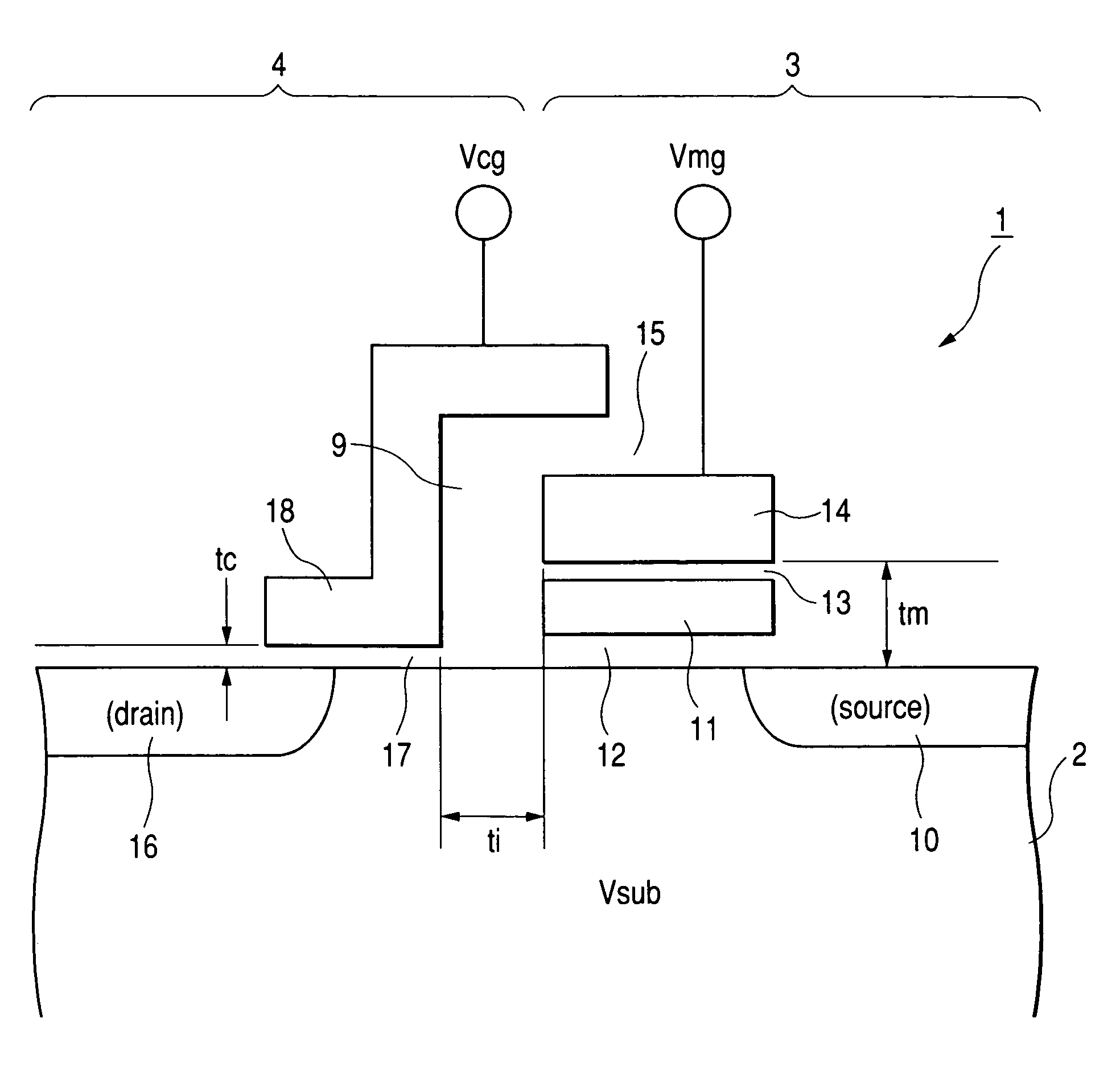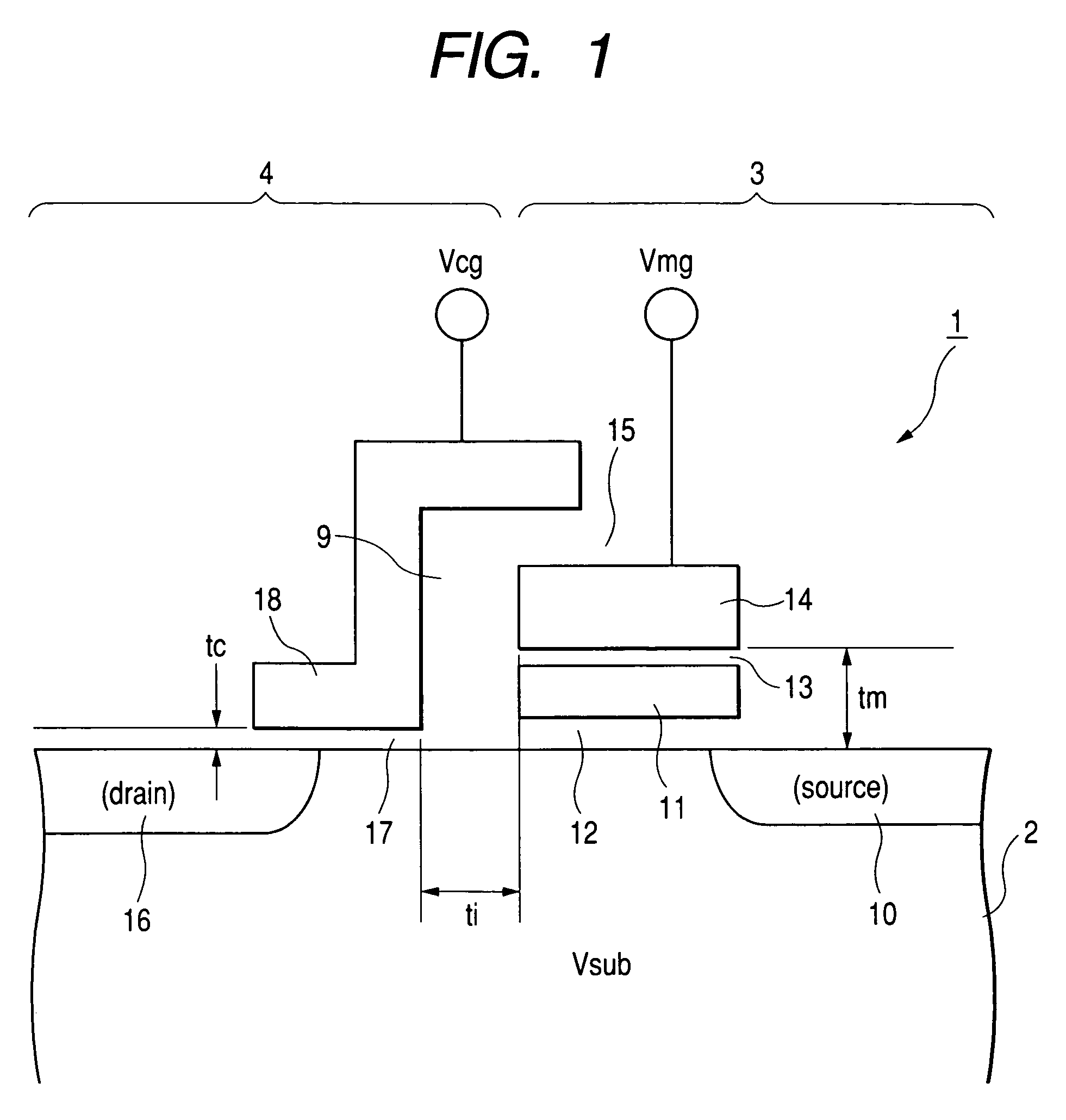Nonvolatile semiconductor memory device employing transistors having different gate withstand voltages for enhanced reading speed
a nonvolatile, memory device technology, applied in the direction of solid-state devices, digital storage, instruments, etc., can solve the problems of insufficient speeding up by hierarchized bit line structure based on main/sub bit lines, fragment gate type memory cells are not suitable for high-speed operation under low voltage, etc., to achieve the effect of improving the read speed and low cos
- Summary
- Abstract
- Description
- Claims
- Application Information
AI Technical Summary
Benefits of technology
Problems solved by technology
Method used
Image
Examples
first embodiment
[0161]FIG. 40 is a cross-sectional view showing the present invention, which is illustrative of a memory cell using a floating gate. The memory cell comprises a p type well region PWEL provided over a silicon substrate, an n type diffusion layer MS which serves as a source region, an n type diffusion layer MD which serves as a drain region, a floating gate FLG, a tunnel oxide film FTO, an interlayer insulating film INTP, a memory gate electrode MG (material: n type polysilicon) for applying a high voltage upon writing / erasure, an oxide film CAP for protection of the memory gate electrode MG, a gate oxide film STOX for a selection MOS type transistor, a selection gate electrode SG made of n type polysilicon, and an insulating film GAPOX for insulating the selection gate electrode SG and the memory gate electrode MG. The gate oxide film STOX is characterized in that the thickness of the gate oxide film STOX is fabricated thinner than that of the insulating film GAPOX and that of a hig...
second embodiment
[0168]FIG. 43 is a cross-sectional view showing a second embodiment where the present invention is applied to a MONOS type memory cell that performs discrete charge storage. FIG. 43 is different from FIG. 40 in that a laminated structure is configured wherein the charge storage region results in a nitride film SIN of silicon, an oxide film BOTOX is formed just below the nitride film SIN, and an oxide film TOPOX is formed just above the oxide film BOTOX. The thickness of the nitride film SIN is set to less than or equal to 50 nanometers. Assuming that the thickness of the oxide film TOPOX is defined as tT and the thickness of the oxide film BOTOX is defined as tB, both tT and tB are set so as to reach a relationship of tB>tT where stored charges are pull out via the oxide TOPOX, whereas both tT and tB are set so as to reach a relationship of tB<tT where the stored charges are pulled out via the oxide film BOTOX. The relationship of the film thickness described in FIG. 42, i.e., tL≦tS...
third embodiment
[0174]FIG. 47 is a cross-sectional view showing a third embodiment where the present invention is applied to a memory cell using fine particles as a charge storage portion. Fine particles DOTS are provided on an underbedding oxide film BOTOX. As the material of each fine particle DOTS, may be mentioned polysilicon. Another material may be used. The diameter of the particle may preferably be 10 nanometers or less. An interlayer insulating film INTOX is deposited so as to cover up the fine particles DOTS, and a memory gate electrode MG is mounted just thereabove. The charge storage portion may be considered to be equal to a charge storage film having a trap property in that it becomes discrete. Accordingly, the contents of the present invention described up to now can be applied in any combination thereof or all combination thereof.
[0175]The relationship of tL≦tS<tH and the cell structure corresponding to the gist of the present invention have been described above. A specific manufact...
PUM
 Login to View More
Login to View More Abstract
Description
Claims
Application Information
 Login to View More
Login to View More - R&D
- Intellectual Property
- Life Sciences
- Materials
- Tech Scout
- Unparalleled Data Quality
- Higher Quality Content
- 60% Fewer Hallucinations
Browse by: Latest US Patents, China's latest patents, Technical Efficacy Thesaurus, Application Domain, Technology Topic, Popular Technical Reports.
© 2025 PatSnap. All rights reserved.Legal|Privacy policy|Modern Slavery Act Transparency Statement|Sitemap|About US| Contact US: help@patsnap.com



